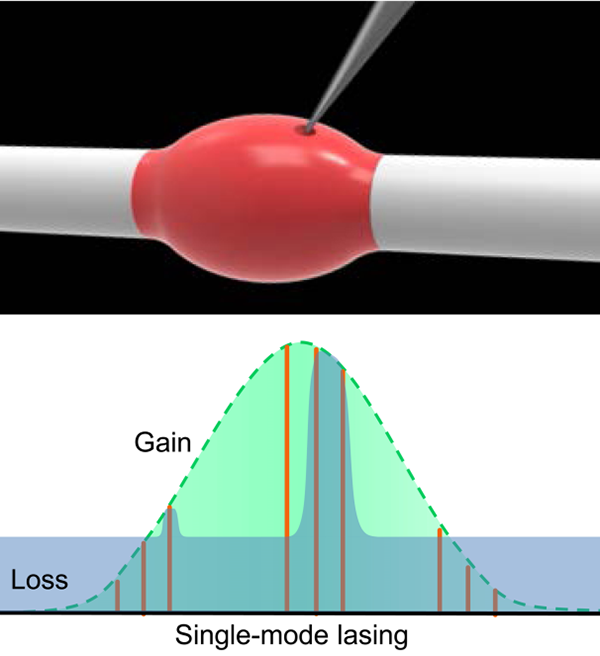Owing to strong confinement of light in ultra-small mode volume, whispering gallery mode (WGM) microresonators have attracted great interest. In previous years, different whispering gallery mode geometries have been investigated such as rings, disks, cylinders, spheres, toroids, polygons and microbottles but due to absence of mode suppression techniques, microlaser produced through these geometries is multimode. Multimode occurrence can be troublesome in distinguishing selective modes for sensing application. So, realization of single mode laser is an essential requirement for sensing and spectroscopy applications. Single WGM lasing can be obtained by decreasing the size of microresonators, coupled cavities in which one cavity serves as a spectral filter to the other one by using the Vernier effect, parity-time symmetry effect and piezoelectric effect.
Among all aforementioned geometries of WGM microresonators, microbottle resonators are new and interesting candidates owing to the highly non-degenerated WGMs with spatially well-separated intensity along the long-axis direction. These modes can be efficiently activated depending on the excitation set-up and make it possible to select the desired modes. Gain engineering via spatial interference excitation and loss engineering via fiber-taper have been investigated to fabricate single mode laser which is then used in a stretchable device for strain sensing. Nevertheless, the fabrication of microbottle resonators usually requires complex and expensive optical systems. It is preferred to have an inexpensive and simple way to fabricate the microbottle resonators. Alternatively, controlling of modes selection via engineering the surfaces and shapes of the WGM microresonators is of great interest for the researchers. Scattering of the light out of the microresonators by adding micro-droplets and micro-grooves on the surface of microbottles can suppress and attenuate the bottle modes.
The microlaser introduced by Dr. Saima Ubaid from a research group which is led by Prof. Fuxing Gu from the University of Shanghai for Science and Technology is single mode which is achieved by surface destruction of polymer microbottle resonators through tungsten probe. The relevant research results are published in Chinese Optics Letters, Vol. 17, Issue 12, 2019 (Saima Ubaid, Feng Liao, Tao Guo, Zhaoqi Gu, Shuangyi Linghu, Yanna Ma, Jiaxin Yu, Fuxing Gu. Direct single-mode lasing in polymer microbottle resonators through surface destruction[J]. Chinese Optics Letters, 2019, 17(12): 121401).
To obtain single mode laser, a bottle shaped polymer resonator is used. Self-assembly fabrication technique is used to fabricate laser dye doped polymer microbottle resonators. The external surface of the microbottle resonators is destroyed by a tungsten probe to reduce the numbers of lasing modes. The tungsten probe is mounted on a triple-axis micromanipulator and is precisely struck to the neck of a microbottle resonator, and in this way small part of resonator’s surface is destroyed. When this resonator is pumped by an ordinary free-space light irradiation, the higher-order bottle modes with large axial orders spatially located around the neck surface of the microresonator will suffer large optical losses while rest of them are excited and we can directly achieve single mode lasing from the fundamental bottle modes by destroying again and again. The modes suppression depends on the amount of surface destruction by tungsten probe and the sizes of the microbottle resonators. When this surface destruction method is applied to small microbottle resonators, achievement of single mode lasing is very easy by just slightly touching tungsten probe. While increasing further the outer diameter of microbottle resonators, it is difficult to achieve high purity single mode lasing yet it is an effective way to get mode reduction in these resonators. Additionally, the obtained single mode lasing has attractive advantages of high side mode suppression ratios and low thresholds.
Prof. Fuxing Gu believes that this method can be improved by using piezo-stages with nanoscale positioning resolutions to drive the tungsten probes in the future, so that we can select the single lasing modes more precisely. This method is very flexible, inexpensive and convenient, and may find wide promising applications such as lasing and sensing devices.


Single-mode lasing by simply using a tungsten probe to destroy the external neck surface of polymer microbottle resonators. The higher-order bottle modes with large axial orders will suffer large losses. Using free-space light beam will directly generate single-mode lasers.


